
Magdalena - founder of Uccelerate and UX researcher
Curiosity drives everything I do.
Innovative user and product researcher with 3+ years of experience, skilled in selecting and adapting methodologies to uncover deep user insights, crafting compelling narratives and creating brands users love. Also, a co-founder of Fashion Cognition Lab, investigating the psychological influence of clothing.
Magdalena bozek-szczotka - UXR portfolio




evaluative
Generative
See selected case studies below:
Mixed methods usability of a US mortgage readiness platform
Identifying personas in the phone rental market
Feature prioritisation for phone subscription
1.
2.
3.
Feature prioritisation for phone subscription Spring+
evaluative-based case study
CONTEXT
Spring was developing a new, innovative rental platform for tech products, with the potential to disrupt the existing ownership-based consumption model. This emerging niche represented a significant opportunity to offer customers more flexibility and sustainability in how they access and use personal technology.
Spring+ is an enhanced offering from Spring’s phone rental platform aimed at delivering a premium post-rental experience. The goal was to identify the key features that customers value during the post-rental stage (Contract Management) and explore opportunities to enhance the overall user experience.
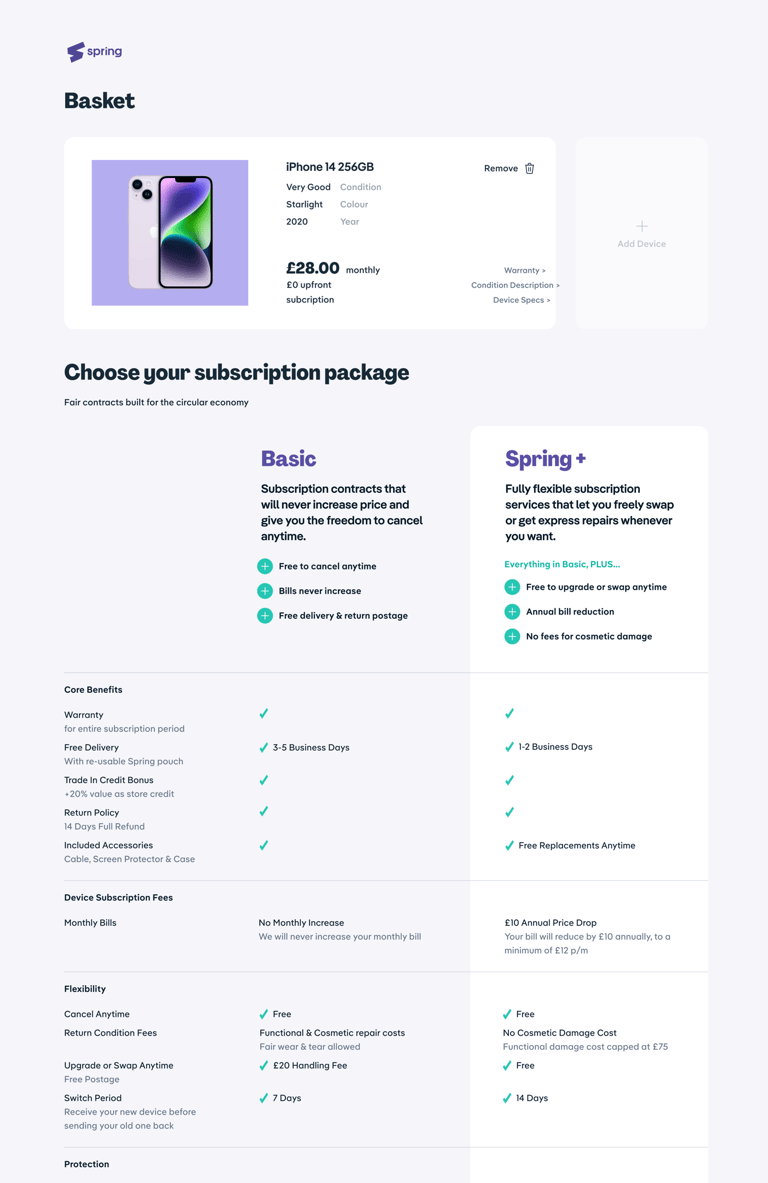

Objective
methodology
A complex study consisting of 4 stages and bespoke methodologies crafted based on innovative UX methods I found in industry-related articles.
The process
Buy a Feature focus group
I started with a screener to gather demographic data of participants and scenario-based questions to understand participants' value/cost ratios when selecting phones. Before conducting the actual focus groups, we ran a trial session in the office, revealing preliminary insights.
In the 3 focus groups (with differing phone acquisition models) that followed, participants ranked 10 Spring+ features and attached a price to the package. After a group discussion, they re-ranked the features with the option to remove some or reassign them to the non-premium offering, allowing for collective prioritization.
Even though focus groups don't accurately predict future behaviour, they can help gauge attitudes and guide future exploration. Here are some key takeaways:
Flexibility was identified as the primary selling point of rental, with cost and device protection as concerns
Phone owners leaned towards rental as a short-term option, while those on contract preferred long-term rental (familiarity)
Must-have features are switching anytime, express repair, reduced excess, and no fee for returning in poor condition
Next-day delivery was asked to be included for free, and interest in premium bonus credit/100GB storage/10% discount was limited
Recommended pricing was £10-£15, lower end ideally
In the presentation, I've included video snippets from the user interviews to bring the personas to life for the team.
I added a lot of insights and recommendations to provide direct improvements to the value proposition for the team.


IMPACT
Although the project started as an evaluative effort, I uncovered deep foundational insights, particularly in user segmentation. While validating hypotheses against internal expectations, the deeper insights we gained were key. Not only did we finalize the Spring+ package, but we also uncovered the underlying motives behind why certain features were most appealing to different segments. I synthesized these segments and personas into final personas that were exceptionally clear and easy to understand serving as clear reference points.
Understanding mindsets, deeper behaviour and attitude drivers allowed us to extend our insights beyond product design. This knowledge has been invaluable for the entire organization, guiding marketing and communication strategies that resonate with user motivations, ultimately aligning broader business objectives with a user-centric focus.
The impact extended beyond the project, earning me recognition for my proactive approach in refining methodologies and ensuring broader strategic thinking.

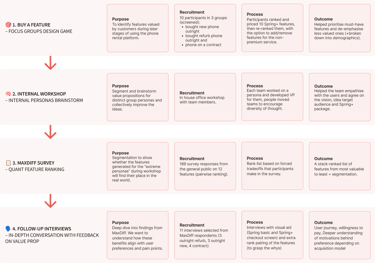

The goal:
To identify the key features valued by customers during Stage 4 (Post-rental & Contract Management) of using the phone rental platform.
To identify potential "nice-to-have" features that could enhance the user experience.
To explore opportunities for future iterations to improve the service.


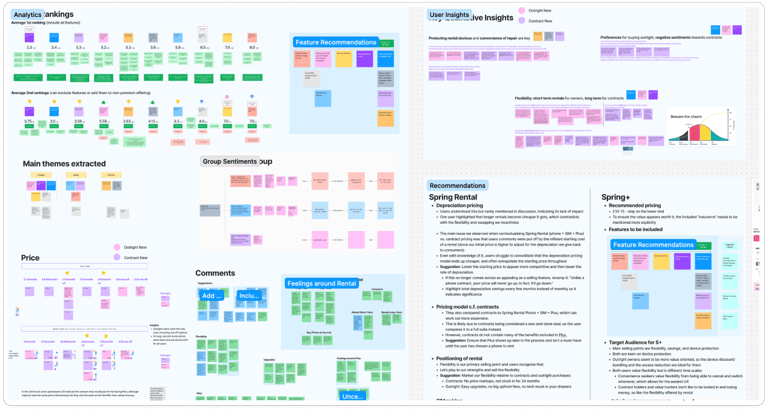

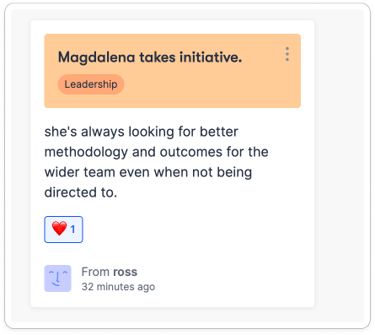

The effect of this research project was a Spring + package with validated features


Notes from a focus group outlining the hierarchy of features ranked by participants during the focus group, along with notes from their discussions.
Personas workshop
Inspired by a Medium article on Rapid Personas, I've proposed a workshop session with the team. The focus groups provided us with some distinct personas and a taste of what they value and prioritise in such a service. We wanted to step out of the box, brainstorm different Spring+ propositions and hear out the justification for them from the team.
Analysis overview
MaxDiff ranking survey
The next step was to test whether the features generated for “extreme personas” resonated with a broader audience. We conducted a large-scale MaxDiff survey to identify the most appealing features.
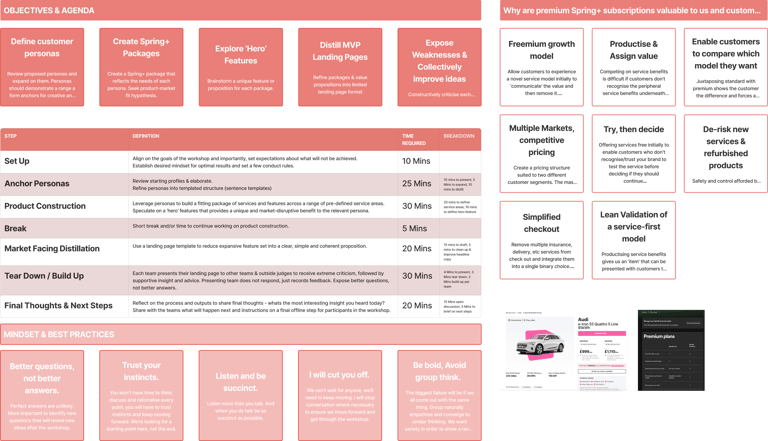

Each team was assigned a persona and then swapped members to ensure fresh perspectives.
Teams then ideated landing pages to distil their ideas into clear propositions.
The goal was to identify a standardized feature set and refine the target audience for Spring+.
Workshop overview
"Experimental nomad" persona output notes
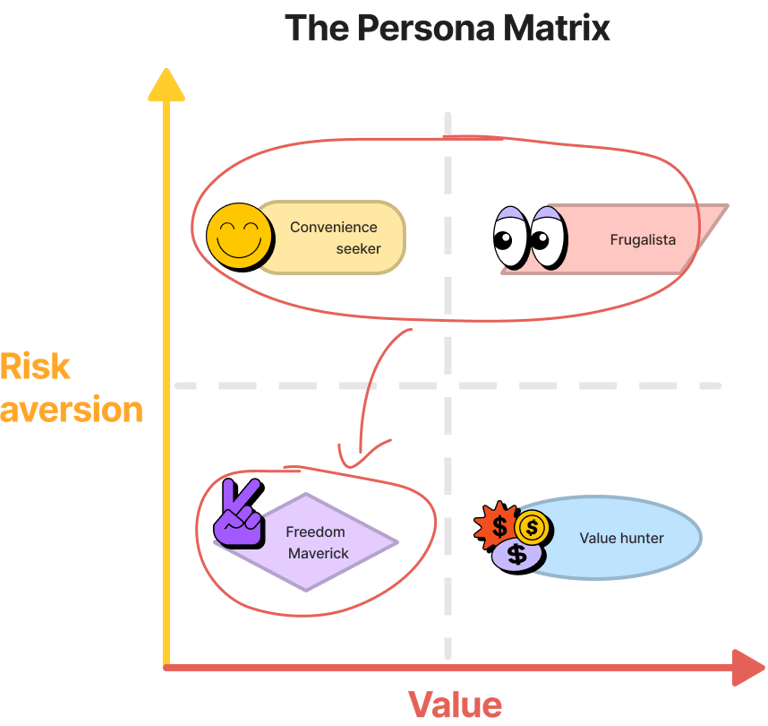

After the workshop, I observed a relationship between user segments based on their risk aversion and value focus. Convenience Seekers (usually phone contract users) and Frugalistas (outright purchasers) are both risk-averse, favouring established services.
There was a potential to attract both groups by reducing the perceived risks of commitment and cost. Over time, through Spring+ and its flexible offerings, both personas could evolve into "Freedom Mavericks"—users who embrace the extra opportunities and freedom our service provides.
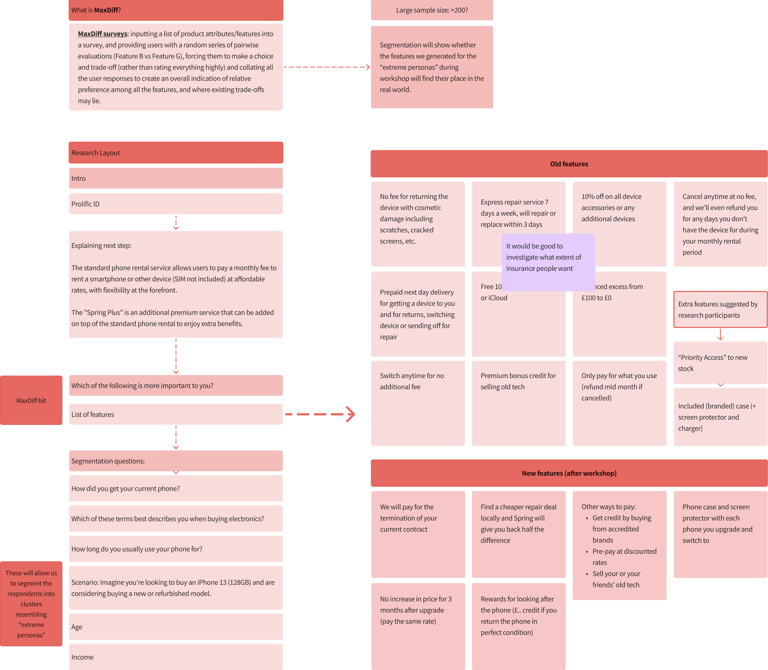

The outline of the MaxDiff survey
I chose this method inspired by an article about Quantitative Concept Testing. By employing this methodology I wanted to narrow down refined features with a large sample to the most promising ones.
10 features (further refined after the workshop) were segmented into pairs and randomly shown to participants. Participants chose the most and least valuable in each subset.
Respondents were also segmented by impulsiveness, experimental attitudes, and value focus. This allowed us to determine which features matched specific personas and to synthesize a standardized offering that would appeal to a wider audience while accommodating diverse preferences.
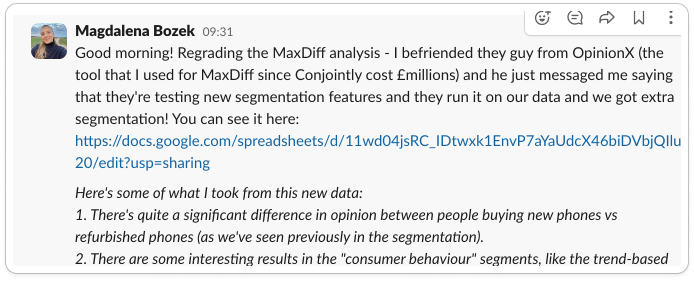

I saved on the budget by securing a free upgrade to the top-tier survey package.
Follow-up in-depth interviews
After analysing data from the MaxDiff survey we wanted to dive deeper into the why and the sentiments towards phone rental and Spring+ packaging to further refine the offering. We had already designed a visual prototype of what the package would look like, so we also wanted to get feedback on that and evaluate it.
I crafted an interview guide to explore four key pillars: value, flexibility, protection (insurance), and environment. Additionally, in the end, I gathered their views on our fully developed Spring+ package and examined why participants favoured certain feature pairings in MaxDiff.
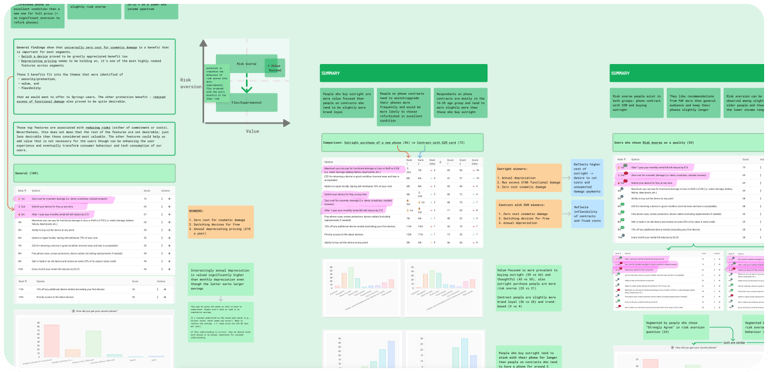

Overview of the MaxDiff analysis

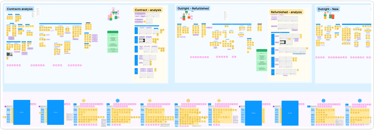






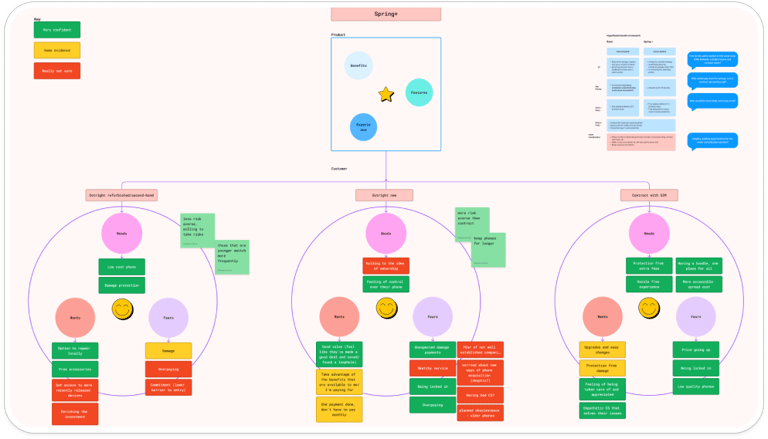

Value proposition hypotheses for each user segment in terms of confidence level we had in the data supporting it
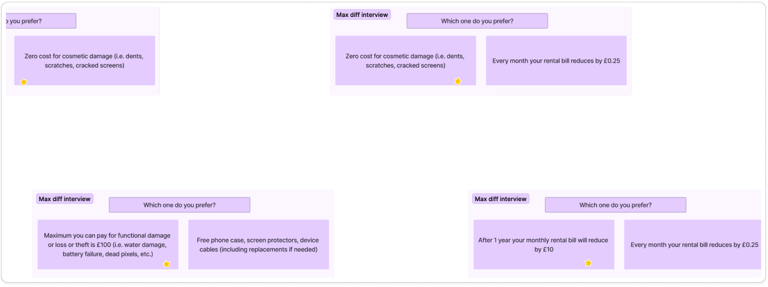

MaxDiff version in the user interview to get to the roots of the answer (based on participants' survey responses)
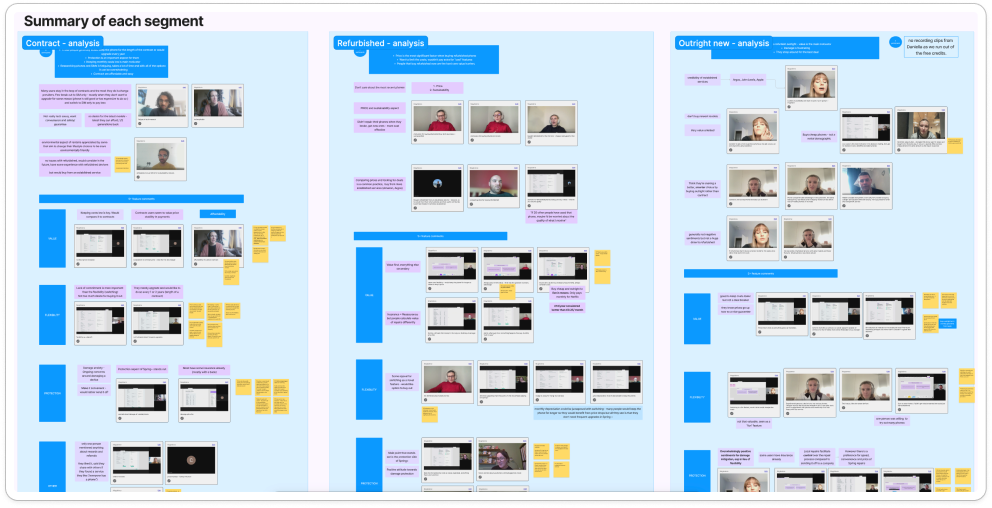

Overview of the interviews analysis and affinity mapping

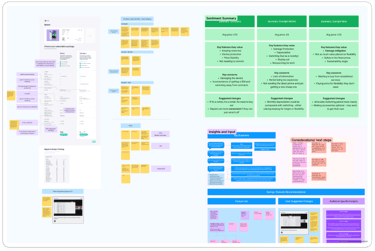
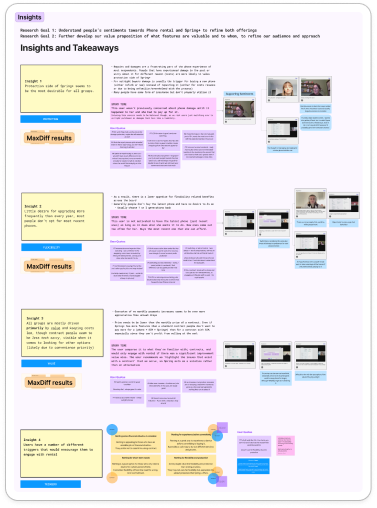


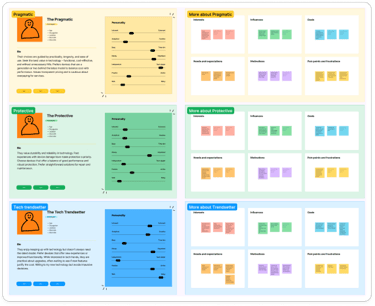


The final value proposition for Spring+ was not only finely refined but thoroughly validated, significantly boosting team confidence in this concept compared to the start.
Beyond just enhancing Spring+, this effort laid the foundation for ongoing user-centred product development.
1.
Mixed methods usability study of a US mortgage readiness platform FinLocker
Hybrid case study (generative + evaluative)
CONTEXT
FinLocker developed an app (under various names) aiming to transform the way US consumers prepare for a mortgage.
They partner with mortgage lenders, credit unions, banks, and credit and housing counsellors to provide their customers with a path to homeownership.
FinLocker does not have its own brand in consumers' minds. They use the branding of their partners
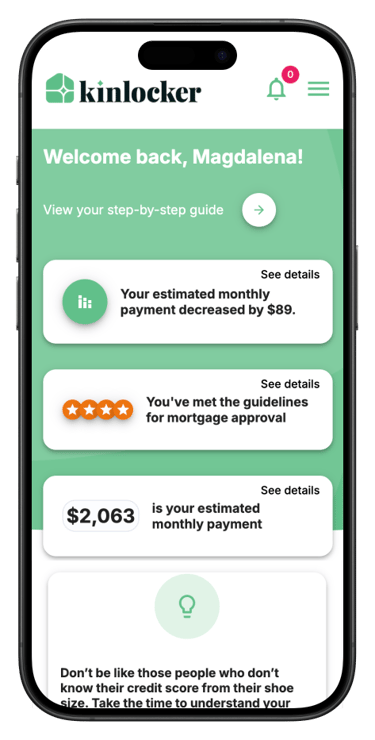

FinLocker was looking for more guidance in their decision-making. They wanted to leverage data and validate some hypotheses they developed.
They chose Uccelerate as other agencies’ timelines did not meet their expectations and they were looking for an unusual depth of insight and perspective. In the previous research efforts, there was never any investigation of current users, so we suggested that as the focus of the project.
RESEARCH NEEDS
KICK OFF
We began with a workshop where I aimed to thoroughly understand their needs, the product, their assumptions, and any prior research that had been conducted.
Based on this, I developed a tailored research plan, which I shared for approval, ensuring we had a clear focus moving forward.
METHODOLOGY
OBJECTIVE
Understand the profile, pains&needs of current users of the app
Focus on super user - understand how they approach home-buying and what’s their perceived value
Identify the pain points experienced while using the app and what triggers the use
Refine the value proposition and UX based on the findings





2 weeks - kick off + research plan
2 weeks - survey design and data collection
3 weeks - interviews and analysis
1 week - reporting and read out




We reached out to FinLocker’s existing users
We received 29 responses
I interviewed 5 users and got their feedback on their home-buying journey and the app
Longer than expected due to time-consuming process of user-recruiting
RQ: What’s unique about the FinLocker's app?
RECRUITMENT
One unique aspect of this project was that we didn't have direct access to the users.
FinLocker wanted to be the intermediary between me and its users. Privacy was really important for them. Therefore, all communication went through FinLocker’s CPO. I developed a communication strategy, while FinLocker's team approved and handled the outreach themselves. This approach challenged us to be creative and collaborative, ensuring that our strategy aligned perfectly with their needs.
From users who completed the survey, I selected participants for in-depth user interviews.
Incentives for research participation:
$150 lottery price for the survey.
$20 Amazon voucher incentive for completed interview.
PROCESS

It’s all in the questions I ask
I employ the Jobs to Be Done framework during interviews to extract actionable insights.
"Can you tell me more about what specifically made you download the app and what you expected to gain from it?"
Answer: "um I wanted something that could keep me posted on my credit score that wasn't like the credit card companies kind of gauge me [...]"
I deep dive into the notions found in the survey responses
"You mentioned in the survey that the emotions you associate with the home-buying process are optimism and motivation. Can you elaborate on why you feel this way?"
Answer: "Right. I don't know. I love real estate. I love the idea of what it can do for many generations and I think because I wasn't educated. Um, like I was always told you know [...]"
ANALYSIS
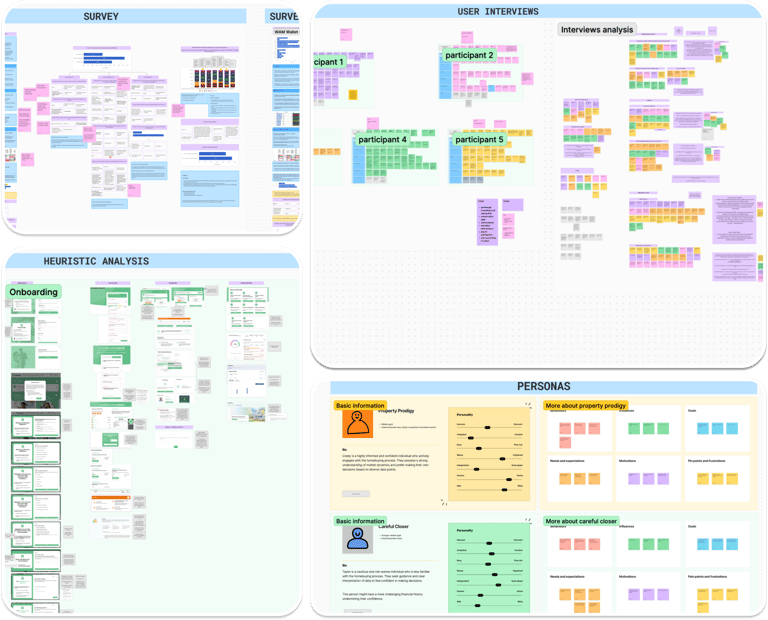

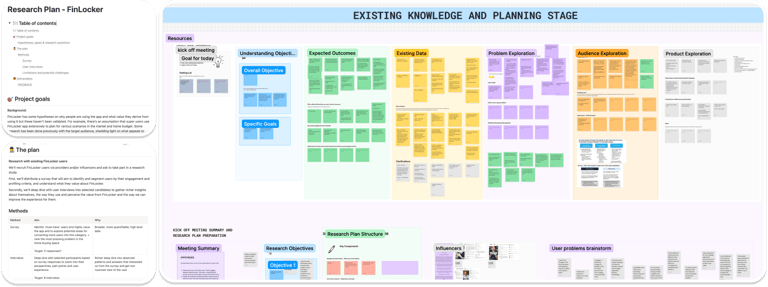

I analysed and stored all the data in FigJam file.
Thematic analysis and affinity mapping were used to analyse qualitative data and complement quantitative findings
+
Heuristic analysis was conducted to audit the onboarding UX.
Personas were developed by segmenting user data.
I used behavioural and psychological theories to support our recommendations.
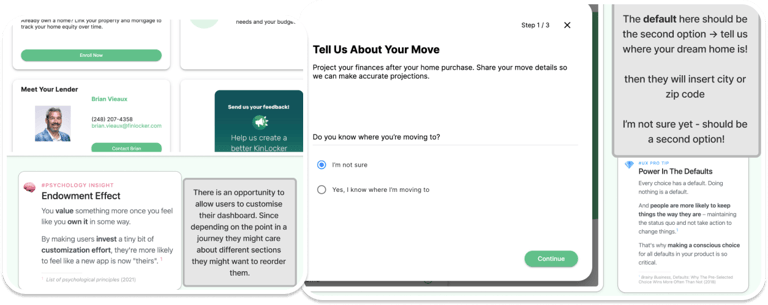

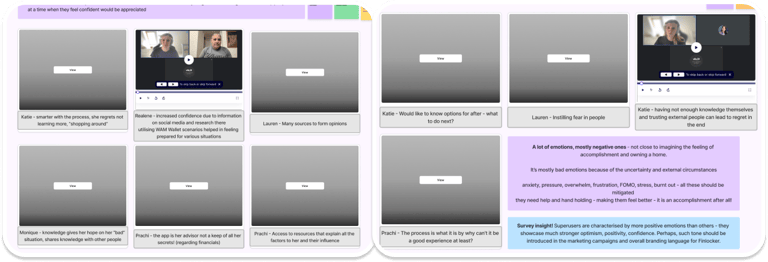

I included video snippets from interviews to increase user empathy and bring research to life!
IMPACT
Direction for the team
As the findings unfolded, it felt like the missing pieces of their puzzle were falling into place. The team gained clarity on where to focus their efforts in refining their value proposition moving forward.
The findings guided product development in areas where FinLocker was looking for validation. Our recommendations were successfully implemented and well-received among the product team and executives.
FinLocker also realised they should adapt their communication strategy to focus on being more of a long-term partner in the home-buying journey rather than a short one to secure a home straight away (which is how lenders and agents are perceived).
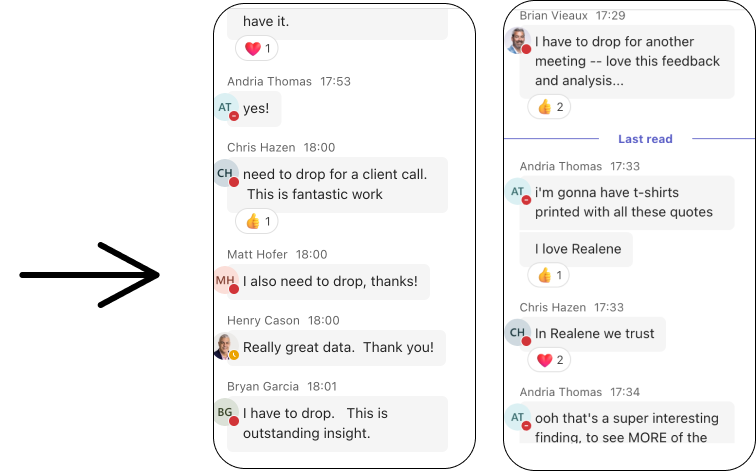

The research made a powerful impression on executives, so much so that they decided to develop a case study to share with their partner organisations!
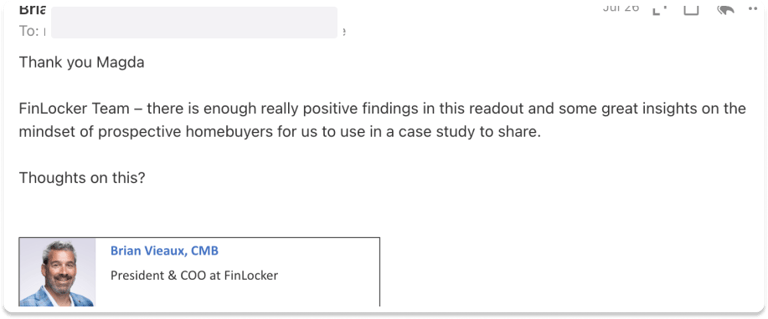


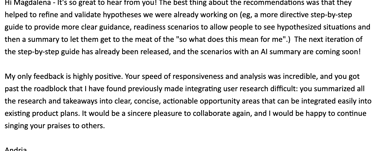
I reached out to the CPO for feedback on our collaboration which couldn't have been more positive!
3 months post project update:
FinLocker has updated the designs of their platform and implemented the recommendations we proposed, they:
Moved the most valued feature we identified (across all segments and user journeys) up in the dashboard
Refined step-by-step guide to reflect what it means for the user and their situation
Perfected the value proposition they share in the early stages of user acquisitions
The impact we achieved was an 11% increase in the engagement of current users and a decrease in the abandonment rate in the first screen of almost 35%!
2.
Identifying personas in the phone rental market
GENERATIVE-based case study
CONTEXT
Spring, a London-based startup in the refurbished tech space, was on a mission to revolutionize the way people interact with personal technology.
Their goal was to develop a new, innovative rental platform for tech products, with the potential to disrupt the existing ownership-based consumption model. This emerging niche represented a significant opportunity to offer customers more flexibility and sustainability in how they access and use personal technology.
I led the UX research for this project, focusing on gathering foundational insights to guide the design of the rental platform.
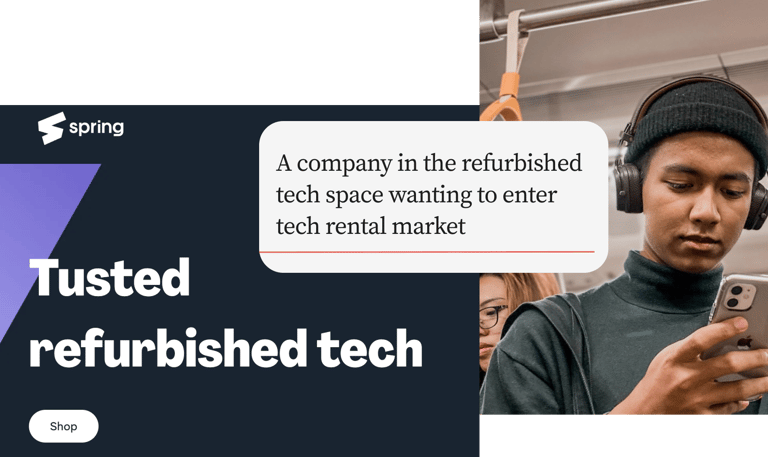

With the rental market still niche and underexplored, Spring needed a deep understanding of user behaviours and attitudes to shape their product development.
Initially, the team relied on my in-depth literature review on rental attitudes and psychological barriers (see below). As with many startups, they wanted to move quickly, leading to the development of a prototype, which I tested through usability sessions.
RESEARCH NEEDS
Approach Pivot
During usability testing, it became clear that users were confused by the rental model and continued to interact with the prototype through the lens of default mental models (traditional tech ownership). This revealed a deeper issue: the mental shift required to embrace rental was not being addressed. Users didn’t fully understand the benefits, highlighting the need for a different approach.
I recommended that we step back from the prototype and instead focus on understanding people who had already adopted the rental model. We lacked fundamental research.
By identifying those individuals and conducting in-depth interviews with them, we could gain insights into how their thinking had shifted, which would help us design a product that effectively communicated the value of rental and eased the transition away from ownership.
Objective
methodology


Continuous in-depth interviews with people who already rented from our competitors (Raylo, MusicMagpie, Ooodles, Grover).
I always dig for theories that explain the behaviour and attitudes in a given environment.
Interview guide
RQ: What characterises people who rent phones?
Introduction (2 minutes)
Part 1:
Warm-up questions
Firstly, to start off could you briefly tell me about your general phone usage habits.
What are the main activities or tasks you use your phone for?
When it comes to your phone, what is your primary goal?
(Cost effectiveness/Flexibility/Ownership/Novelty)
Who are they - demographics, lifestyle, values - what do we need to understand about them as a person?
Can you please share your age and gender and where you live (city vs country)
What does a day in your life look like, incl. occupation?
Pre-rental
How did you get your previous phone before you started renting?
Tell me about the challenges you faced with this model. (they may talk about high costs, mid-contract spikes, upgrading, admin, lack of flex etc.)
The switch to rental
Walk me through what was happening in your life at the time that you decided to switch to rental?
How did you come across the concept of renting a phone? I.e. Recommendation, research, social media ad etc.
When you found out about phone rental, did you have any doubts or suspicions? Was anything unclear to you about rental?
How did you go about finding options available? Music Magpie/Raylo/Ooodles (whatever they rent with)
What core problem does rental solve for you? (probe)
What motivated you to choose renting a phone instead this time? What do you hope to achieve through this rental model? (probes)
Rental experience
Tell me a bit more about your rental plan.
Who do you rent with? Music Magpie/Raylo/Ooodles?
How did you decide on which rental company to choose?
How long have you had your rental? How long is the overall rental term?
What aspects of phone rental do you find appealing or valuable? What are the benefits or advantages?
What sets your current phone rental service apart from other options in the market?
How do you perceive the overall value for money when renting a phone? Do you feel that the cost justifies the benefits and convenience provided? (optional probe)
Tell me about the challenges or frustrations you’ve experienced whilst using (rental service)?
Could you describe those situations and how they were resolved (or not)?
How important is flexibility in terms of phone models and plans when it comes to renting a phone? (optional probe)
Have you upgraded or switched your device yet? Could you tell me about that experience - what was the process and how did you find it?
Do you have insurance coverage for the rented phone?
Mental models
When you think about renting a phone, what does it remind you of? Any similar products or services that come to mind?
Do you currently use any other subscription-based services? If yes, how does the experience of renting a phone compare to those services?
What tasks do you typically complete when you rent a phone, both during the ordering process and while managing the subscription?
Target audience defined by users
Who do you think would be interested in renting a phone? Can you describe their demographics or lifestyles?
Have you ever recommended phone rental to anyone?
If yes, what specific factors or needs made this person a good fit for renting? - what’s their lifestyle like, why did you recommend it to this particular person, what do we need to know about them
Part 2:
Prototype feedback
[Show the prototype and let them compare it to their provider]
[Ask the participant to compare it to their current phone rental service, highlighting similarities, differences, and any preferences they may have.]
Are there any additional services or accessories related to phone rentals that you find valuable or would like to see offered?
[Let them go to the product page of iPhone 14 pro and see their views on the cost calculator]
Ending remarks and housekeeping (2 minutes)
ANALYSIS and findings
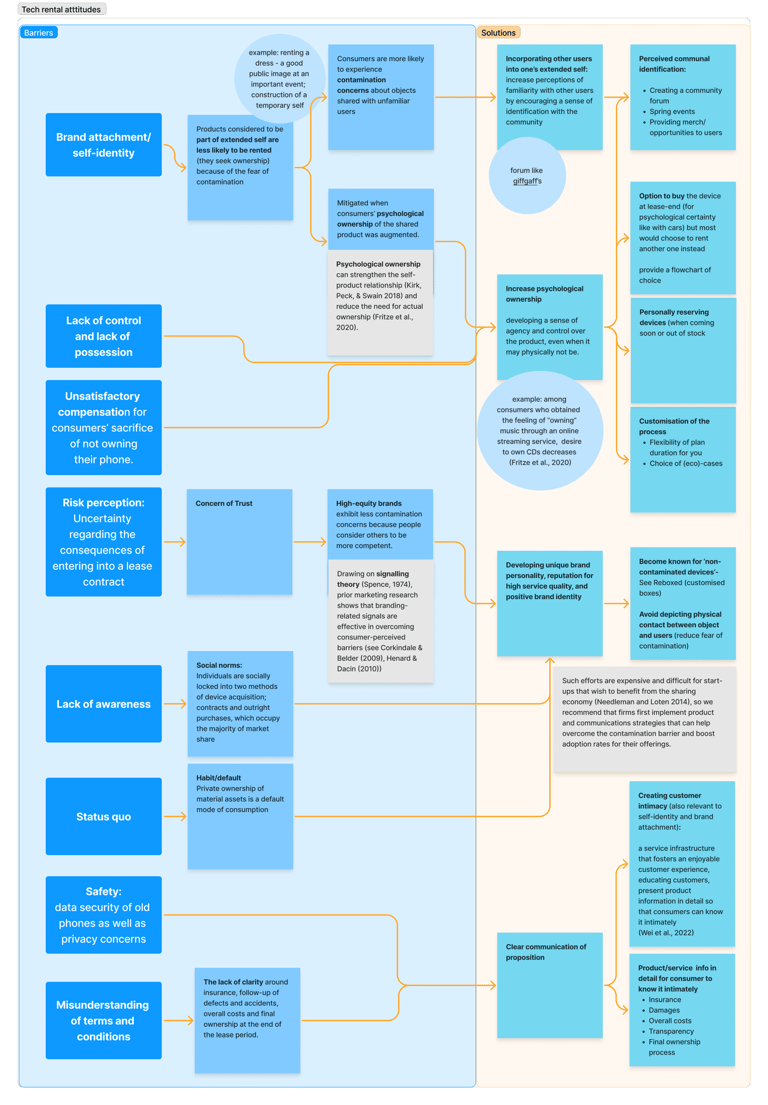

I analysed and stored all the data in a FigJam file.
Thematic analysis and affinity mapping were used to analyse qualitative data.


This shift led us to focus on building personas rooted in the real experiences of people who had successfully made the behavioural leap to tech rental.
As a result, we gained clarity on how to approach different segments, where to find them, and what truly mattered to them. This helped us not only address their specific needs but also guide them through the mental shift required to embrace rental as a viable alternative to ownership.
IMPACT
Our research had a transformative effect on how Spring approached both its product and marketing strategy. By deeply understanding the motivations and behaviours of rental users, we were able to refine our value proposition and shift our marketing to better explain the unique benefits of tech rental.
This raised deeper, ongoing questions which became a compass for our future efforts:
How might we increase the likelihood of non-rental users switching to Spring?
How might we convince current rental users to choose Spring over competitors?
How might we spark conversations and recommendations about Spring in a way that feels organic and genuine?
The research also shifted the internal dialogue within the team. Every member began referring to user personas in a more personal way, with labels like "value hunter" for users focused on finding the cheapest option. This language brought a clearer sense of who we were designing for, making our discussions more focused and empathetic. Instead of generic user groups, we now talked about individuals with distinct needs and behaviours, helping to drive more nuanced and user-centric decisions.

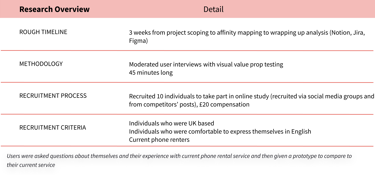

The goal:
Better understand the audience who rents devices and eventually decide on the target audience or at least narrow it down
Gather user stories that will allow us to put our proposition in a context that is understandable for users
Understand the mental models that users of rental services use when interacting with rental service
Understand what’s actually unique about our offering compared to the market



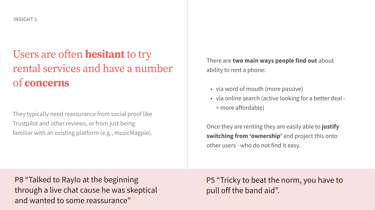
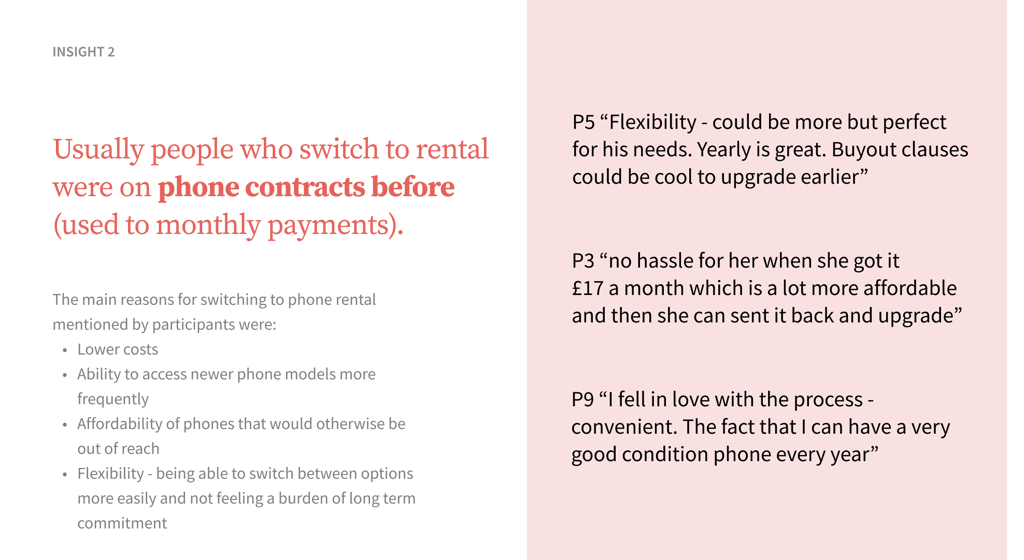


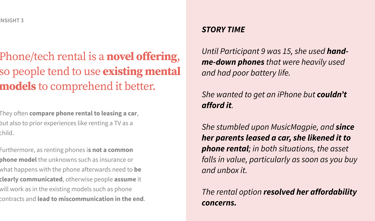
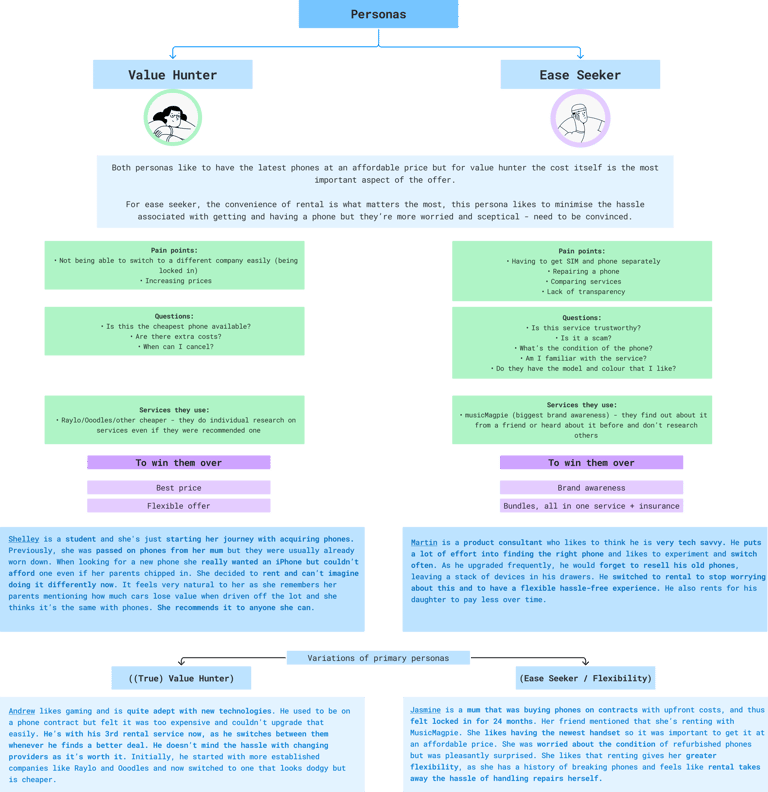

3.
Get in touch
If you have any questions about my previous projects or would like to work with me!
magdalena@uccelerate.com